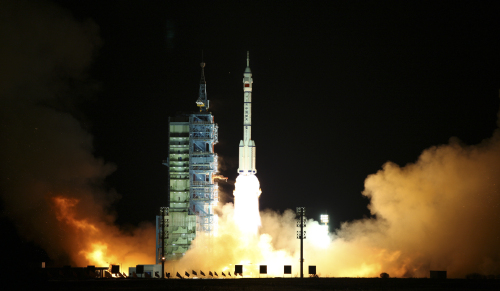China took a crucial step towards fulfilling its ambition to set up a manned space station on Thursday by completing its first successful docking high above Earth, state media reported.
The Shenzhou VIII spacecraft joined onto the Tiangong-1 experimental module at 1737 GMT, silently coupling more than 343 kilometres (213 miles) above the Earth's surface, the Xinhua news agency said.
The spacecraft, whose name translates as "divine vessel", is a modified version of the capsules that took the first Chinese astronauts into space as part of the rising power's ambitious exploration programme.
China aims to complete construction of a space station by 2020, a goal that requires it to perfect docking technology -- a delicate manoeuvre that the Russians and Americans successfully completed in the 1960s.
The technology is hard to master because the two vessels, placed in the same orbit and revolving around Earth at high speed, must come together progressively to avoid destroying each other.
China sees its space programme as a symbol of its global stature, growing technical expertise, and the Communist Party's success in turning around the fortunes of the once poverty-stricken nation.
Chinese leaders including Premier Wen Jiabao were at the Beijing Aerospace Flight Control Center to watch a live broadcast of the docking, while President Hu Jintao, who is in France for the G20 summit, sent a congratulatory message.
"Breakthroughs in and acquisition of space docking technologies are vital to the three-phase development strategy of our manned space programme," Hu said.
The docking took eight minutes and was aided by microwave radars, laser distance measurers and video cameras.
The two spacecraft, each weighing about eight tonnes, smoothly captured, cushioned, connected and locked onto each other, Xinhua reported.
"To link up two vehicles traveling at 7.8 km per second in orbit, with a margin of error of no more than 20 centimetres, is like 'finding a needle in a haystack'," Zhou Jianping, chief designer of China's manned space programme, said.
"This will make it possible for China to carry out space exploration on a larger scale."
He said the country was now equipped with the technology and capacity to construct a space station, adding that Shenzhou VIII might be used as the prototype for a series of spaceships.
China plans to make more than 20 manned space voyages in the next decade, Xinhua said.
A Chinese astronaut trainer is among six volunteers who will emerge on Friday into the outside world after spending almost 18 months in isolation at a Russian research centre to test the effects on humans of a flight to Mars.
China began its manned spaceflight programme in 1990 after buying Russian technology and in 2003 became the third country to send humans into space, after the former Soviet Union and the United States.
In September 2008, the Shenzhou VII, piloted by three astronauts, carried out China's first space walk.
The Shenzhou VIII spacecraft took off on Tuesday from the Jiuquan base in the northwestern province of Gansu from where Tiangong-1 -- or "Heavenly Palace" -- also launched on September 29.
The two vessels will stay linked together for around 12 days before separating and uniting again at a later date, said Wu Ping, spokeswoman for China's manned space programme.
If this mission is a success, China will launch two more spacecraft next year to dock with Tiangong-1 -- the Shenzhou IX and Shenzhou X -- at least one of which will be manned.
Two women are among the astronauts who are training for this mission, Xinhua said. If they are chosen to go, they will be the first women to be sent into space by China.
In preparation for the manned flight, two life-size dummies have been placed on board Shenzhou VIII.
Electronic data will be transmitted back to Earth to help researchers assess the impact of the flight on human breathing, temperature and blood pressure.
The spacecraft is also being used by Chinese and German researchers to conduct joint experiments in life sciences and microgravity, the first time another country has been given any access to China's manned space programme.
China plans to launch a space laboratory before 2016, and hopes to have a space station in orbit capable of accommodating long-term stays in space by around 2020, officials have said.
<한글기사>
中 첫 우주도킹성공, 한국은 언제?
중국이 3일 새벽 실험용 우주정거장 모듈인톈궁(天宮) 1호와 무인 우주선인 선저우(神舟) 8호의 도킹에 일제히 환호했다.
후진타오(胡錦濤) 국가주석은 G20(주요 20개국) 정상회의 참석을 위해 프랑스 칸을 방문하는 중에 성공했다는 보고를 받고 즉각 축하 메시지를 보냈다. 후 주석은 전보를 통해 원활한 첫 도킹 성공을 환영했다.
원자바오(溫家寶) 총리, 시진핑(習近平) 국가부주석, 리커창(李克强) 상무부총 리를 비롯한 중국 수뇌부도 새벽 시간에 베이징(北京)에서 성사 여부를 숨죽여 지켜 보다가 성공을 확인하고 자축했다.
관영 신화통신은 이날 새벽 "중국의 우주 기술력이 세계에 이롭다"는 내용으로 톈궁 1호와 선저우 8호의 첫 도킹 실험 성공의 의미를 강조했다.
통신은 이번 도킹 성공으로 중국이 영구적인 우주정거장 건설의 기대에 한 걸음 더 나아갔다고 평가하면서 중국은 우주 정거장 시설을 국제사회에 기꺼이 개방할 것 이라고 덧붙였다.
통신은 아울러 우주개발 프로그램이 가까운 미래에 많은 경제적 이득을 가져다 주지는 못하더라도 우주과학 기술의 잠재적인 가치가 폄하돼선 안 된다고 역설했다.








